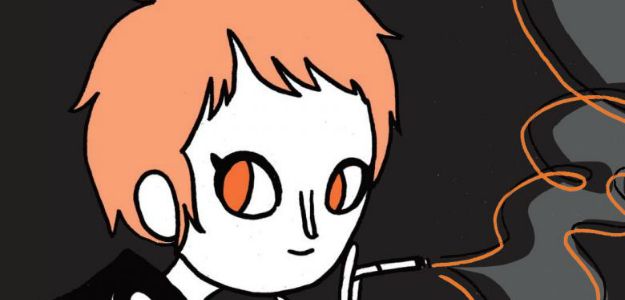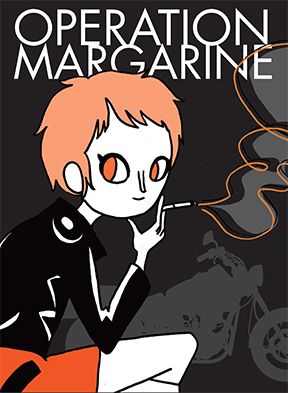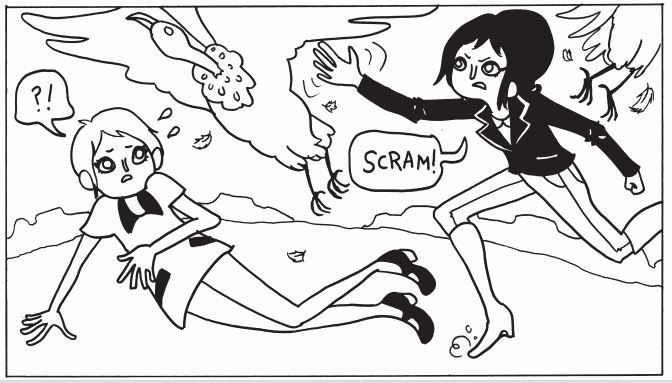April 2014 marks two years since the release of Katie Skelly's Nurse Nurse. In one of those great coincidences, this is also the month that sees the release of Skelly's new book, Operation Margarine.
Her narrative focus has shifted from Nurse Nurse's futuristic sci-fi vibe to the motorcycle road trip (and accompanying drama as well as conflict, plus a few nuns) of Operation Margarine. It was a delightful surprise to learn her new work's connection to Roland Barthes' Mythologies.
To catch a glimpse of Skelly's latest 104-page operation, check out AdHouse's preview. Operation Margarine will be in comics shops on April 16.
Tim O'Shea: As Sparkplug noted, Nurse Nurse turned two years old on April 8. How early in the development of your first major work post-Nurse Nurse did you realize you wanted to step away from a sci-fi setting? Can you look back at Nurse Nurse and see ways now that you feel more confident in your abilities as a storyteller?
Katie Skelly: A few months after Nurse Nurse came out I actually started out writing a new story that was a science fiction/fantasy. I knew I wanted it to be about bikers but I was planning to throw in things like robots and a death cult. Then when I sat down to actually draw it I really enjoyed working on the characters Margarine and Bon-Bon and eventually dropped all the more unwieldy ideas and decided to just focus on them and their experiences.
I can definitely look back on Nurse Nurse now and see a shift in confidence; being able to drop the artifice and just say, “okay, let’s see what happens when I keep it simple” felt like the next, right step.
In naming the book Operation Margarine, were you at all inspired by the essay of the same name from Roland Barthes' 1957 book, Mythologies?
Yes, absolutely. Barthes is one of my favorite writers and theorists. My comic obviously doesn’t have a one-to-one correlation with that essay per se, but the Mythologies collection definitely helped put the idea in my head to explore more archetypal themes (for instance, “bad girls,” biker culture, the mystique of the desert, etc.).
You get to draw a lot of motorcycles in this story, did you do a great deal of research about the looks of various models as part of the project--or was that not necessary?
I drew a ton of motorcycles before I started drawing the comics. And then what I found was that all of the details I worked to learn gradually started slipping out of the drawings until I had my own, like, platonic ideal of a motorcycle. Then I’d just use that model over and over again.
How much did you adjust the story from the mini-comics to this final collected version?
The adjustments were pretty minor between the minis and the book. A few continuity things had to be fixed. One page got clipped entirely. And the ending hadn’t been released at all to this point; it’s only in the book.
Do you find writing the dialogue for your stories more challenging than the artistic aspect of your work?
I would say developing a balance between dialogue and the art is the most challenging thing for me. I generally aim for as little dialogue as possible, because I like for my stuff to read as kind of punchy. And that’s a quality I look for in comics I want to read. I’d rather just see someone get punched in the face than be told in 100 words why they needed to be punched in the face.
I am particularly struck at the eyes of your characters, can you talk about your approach to deciding what kind of eyes you use for Bon-Bon and Margarine?
Bon-Bon has more almond-shaped eyes and big, Ronnie Spector eyeliner. I chose those for her because I wanted her to seem more sort of spry and feline. Margarine has bigger, more saucer-shaped eyes with more sort of Edie Sedgwick eyeliner, as she’s a bit more hollow and doll-like. At least in appearance.
I loved the inclusion of a convent of nuns in this story--what prompted that?
I’m honestly not entirely sure. I think it was sort of an unconscious thing. Maybe because I went to Catholic school and something reminded me of that? I think in the story they represent sort of the opposite of a safe haven, or like some sort of interference with the narrative.
Can you recall which came first in your mind: the idea of setting part of the tale in the desert or the great line of dialogue "There's only one thing about it [the desert]...there's nowhere to hide."
I had the idea to set the story in the desert first. And then I went to California for the first time last summer while I was still working on the comic and went into the desert, and that’s what really struck me about that environment. I felt very small but also very visible.
I drove to Joshua Tree Park alone in the middle of July and was just so freaked out by feeling so physically distant from other people. And there were all these signs up, like “heat stroke warning in effect!!” coupled with “turn off your air conditioner or your car will overheat.” I was like, what am I supposed to do here?? It all felt very exotic to me, having lived on the East Coast most of my life. I wish I could do that every summer.
In terms of an iconic message in the story, there is a wanted poster for Bon-Bon and a missing poster for Margarine. Am I right in thinking there is a subtextual message that Bon-Bon wishes she was missed by anyone (her married lover for instance) and Margarine wishes she felt more wanted (by her parents)?
I think that’s an apt interpretation, absolutely.
Many critics and industry observers clearly consider you a storyteller of note. But I am curious to know, what cartoonists/storytellers catch your attention these days?
Right now I’m into Julia Gfrörer, Hellen Jo, Meghan Turbitt, Sarah Horrocks, and Michiel Budel. Wayward Girls is a gift from heaven.
Were you pleasantly surprised when you sold out of Operation Margarine at the recent MoCCA?
Yes, definitely. The book was getting a little bit of internet buzz prior to the show so I had a feeling we would do all right, but I wasn’t really sure what to expect. I’m very grateful.



